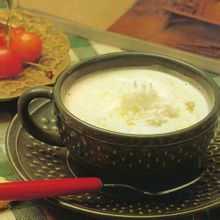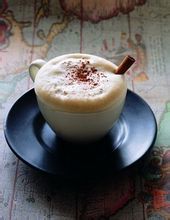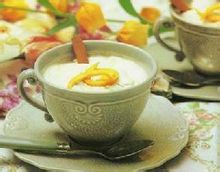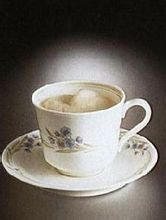Mixed coffee
Mixed coffee is a general term for the classification of coffee, which is not a specific coffee, but formed in history. It is generally composed of three or more different varieties of coffee, which is mixed into another coffee with unique flavor according to its sour, bitter, sweet, fragrant and alcohol.
Introduction editor

Mixed coffee is a general term for the classification of coffee, it is not a specific kind of coffee, but formed in history. About 700 years ago, coffee, known as a magic drink, along with Italy's long water city culture, was brought to other countries in Europe and the United States: Canada, Switzerland, France, the United States and so on. The first way to drink coffee is to extract the juice from coffee beans, but the juice is very bitter and must be treated before it can be eaten. So people try to add milk to the coffee juice and find that it will make the coffee taste more delicious and lighten the bitter taste. In this way, people continue to try to add other ingredients to the coffee juice to make coffee, which is the prototype of mixed coffee. In the following years, coffee gradually stereotyped and developed, and mixed coffee became a category. For example, coffee can be mixed with enough milk, and then if the same amount of coffee and milk are mixed in a certain proportion, it can become Viennese-style milk coffee.
Mixed coffee is generally made of three or more different varieties of coffee, which is blended into another coffee with unique flavor according to its sour, bitter, sweet, fragrant and alcohol. the good comprehensive coffee is fragrant, smooth and refreshing, and the color is golden. It is the top grade of coffee. Mixed coffee drinks are very random, so they seek individual colors.
Development editor

Mixed coffee (figure 1) Coffee was originally enjoyed by Italian residents or gourmets. This makes the coffee have a certain regional character.
With the development of trade, blended coffee has gradually removed this regional limitation, and coffee has become a mixed drink, just like champagne with some wine.
In fact, some people insist that the best coffee is to combine the advantages of different types of coffee, getting sour taste from one coffee, aroma from another, and rich oil from the third-in the words of Fabricant, to "make a strong drink."
The blending of coffee has once become an art form, such as MochaMysore coffee is a very popular mixed coffee. It is a mixture of two very different types of coffee, concentrating the mild aroma of Mysore and the strong flavor of Mocha. But in reality, this is only for commercial purposes. The main purpose of mixing Robbica coffee with Arabica coffee is to reduce the price of Arabica coffee.
There is no doubt that almost all blended coffee is designed to create more profits than a single coffee.

Mixed coffee (figure 2) the key to coffee mixing is its durability. All coffee mixers are looking for a lasting flavor.
For people who have just started drinking coffee, breakfast coffee is an ideal choice. This is a carefully roasted coffee, usually made of African coffee mixed with milk, or a mixture of two moderately roasted Kenyan and Colombian coffees. This coffee is full-bodied and mellow, giving you a good start to the day.
After a meal, mixed coffee chooses the same ingredients, but roasts them deeply to make them taste stronger. One of the best is Indonesian coffee, which is mixed with a little Kenyan, Colombian and Costa Rican coffee.
The deep-roasted mixed coffee has an obvious bitter taste at first, but you'll soon get used to it.
The strongest coffee is a deeply roasted continental blend, which can be made into espresso, but it tastes extremely bitter and is very popular in southern Italy, but it has to be admitted that almost no one is interested in other parts of the Italian conference.
On the other hand, the blended coffee in northern Italy is lightly roasted, evenly textured and slightly sour, much like fine wine.
4 kinds of editors according to the different types of coffee, the mixed coffee will have different characteristics in taste.
(1) mixed coffee with balanced taste
Recipes: Guatemala SHB (30%), Mexico AL (30%), Brazil NO.2?19 (20%), Kilimanjaro AA (10%).
The top comprehensive coffee is the best combination of sour, bitter and fragrant coffee beans, which are mixed together. For example, Guatemalan coffee beans with strong sour taste, Mexican coffee beans with both sour and sweet taste, and Brazilian beans with mild bitterness. Mix these coffee beans in proportion and mix them with Kilimanjaro coffee beans with strong sour flavor. the coffee beans pointed out have a balanced taste and moderate concentration.
(2) bitterness-based mixed coffee
Formula: Sumatra Mantenin G1 (40%), Colombia SUP (30%), Brazil NO.2?19 (20%), Kilimanjaro AA (10%).
To produce strong-flavored coffee beans, you have to choose strong-flavored coffee beans, such as Sumatra mantenin in Indonesia, bitter and sour Colombian beans, and moderately sour Brazilian beans. And Kilimanjaro beans that are mainly sour. The coffee beans made in this way have a bitter taste and are deeply loved by coffee lovers.
(3) mixed coffee with sour taste
Recipe: Kilimanjaro AA, mocha? Plateau Hara (20%), Brazil NO.2?19 (20%), Hawaii Kona NO.1 (20%).
To make sour coffee beans, it is necessary to use Kilimanjaro coffee beans, on this basis, with Ethiopia's soft taste of mocha? Plateau Hara as well as Brazilian beans and moderately acidity Kona, Hawaii, so that you can make a sour coffee mix.
(4) aroma-based comprehensive coffee
Recipe: Guatemala SHB (40%), Kilimanjaro AA (30%), Mocha? Plateau Hara (30%).
The aroma-based mixed coffee is a mixture of coffee beans with different characteristics to make it more fragrant. Mainly fragrant Guatemalan SHB, with sour Kilimanjaro beans and natural fruit mocha? Plateau Hara, can be mixed into a rich aromatic comprehensive coffee.
(5) American mixed coffee
Formula: Brazil NO.2?19 (50%), Mexico AL (30%), Jamaica washed beans (20%).
For those who do not like the taste too much, do not like individual coffee, and only pursue their own taste, American mixed coffee should be the first choice. It uses moderately roasted coffee beans, mainly Brazilian beans with a balanced sour and bitter taste, with sweet and sour Mexican beans and Jamaican water-washed beans with flavor and bitterness, and a unique American mixed coffee was born.
(6) full-bodied and heavy mixed coffee
Formula: Colombia SUP (50%), Brazil NO.2?19 (30%), Java Robusta WIBI (20%).
To highlight the strong taste, it is necessary to choose Colombian beans with moderate acidity and balanced Brazilian beans, as well as rich, bitter coffee. If you want to add some sweetness, you can match some coffee beans with mild bitterness.
5 related nouns edit flavor [Flavor]: overall impression of aroma, acidity, and mellowness.
Acidity [Acidity]: the strong acidity of all coffee grown on the plateau. The sour here is different from bitterness and Sour, and has nothing to do with pH value. It refers to a fresh and lively quality that promotes coffee to exert its functions of invigorating the mind and clearing the taste. The acidity of coffee is not the acidity or sour smell of acidity or alkalinity, nor is it an uncomfortable acid that enters the stomach. When making coffee, the performance of acidity is very important. under good conditions and skills, a special taste with fresh acidity can be developed, which is a necessary condition for high-grade coffee. The sour taste of coffee describes a lively, bright flavor, which is somewhat similar to that used in wine tasting. If the coffee bean lacks acidity, it is equal to lose vitality, taste empty and boring, without layer depth. Acidity has many different characteristics, such as coffee beans from Yemen and Kenya, which have an impressive fruity aroma and a red wine-like texture.
Mellow [Body]: the taste of the tongue after drinking coffee. The change of mellowness can be divided into light to light, medium, high, fat, and even Indonesian coffee is as thick as syrup.
Odor [Aroma]: the smell and aroma emitted after the coffee has been prepared. The words used to describe smell include caramel, carbon roast, chocolate, fruit, grass, malt, and so on.
Bitterness [Bitter]: bitterness is a basic sense of taste, and the sensory area is distributed in the base of the tongue. The bitterness of deep baking is deliberately created, but the common cause of bitterness is too much coffee powder and too little water.
Light [Bland]: coffee grown in lowlands, usually quite light and tasteless. Coffee with insufficient coffee powder and too much water will have the same light effect.
Salty [Briny]: after brewing, if the coffee is overheated, it will produce a salty taste.
The aroma of soil [Earthy]: commonly used to describe spicy and earthy Indonesian coffee, not the smell of dirt on coffee beans. Uniqueness [Exotic]: describes coffee with its unique aroma and special flavor, such as flowers, fruits, and spices. Coffee from East Africa and Indonesia usually has this property.
Aromatic alcohol [Mellow]: used to describe coffee with good acidity balance.
Mild [Mild]: used to describe a coffee with a harmonious, delicate flavor, used to refer to all plateau coffee except Brazil.
Soft [Soft]: describes low acidity coffee such as Indonesian coffee, and also describes it as mellow or sweet.
Sour [Sour]: a sense of taste in which the sensory area is mainly located at the back of the tongue and is characteristic of light roasted coffee.
Spice [Spicy]: a flavor or smell reminiscent of a particular spice.
Strong [Strong]: technically, it describes the advantages and disadvantages of various tastes, or the relative ratio of coffee to water in a particular conditioned product. In terms of popular usage, it describes the strong flavor of deep-roasted coffee.
Sweet [Sweet]: in essence, it is like fruit, and it also has something to do with the taste of wine.
Wild [Wild]: describes coffee with extreme taste characteristics.
Wine [Winy]: fruit-like acidity and smooth mellow, created by the contrast of special flavor.
6 the editor of the preparation method first adds a slightly deep-fried coffee to the cup, pours the same amount of milk into the milk pan, boils over low heat, and adds cream before foaming. Don't wait for the foam to disappear.
7 blending characteristics, editing coffee professionals and coffee lovers usually choose single coffee with pure taste, while the mixed coffee can cater to the tastes of more people, especially those who do not adapt to the bitter taste of coffee and prefer sweets, as well as coffee lovers who are keen on DIY creativity. They often mix coffee with special style and taste according to their own taste. To enjoy this special process. In addition, some bars and cafes also offer a variety of coffee drinks for guests to choose from. However, it is not a simple thing to prepare a good cup of mixed coffee. Some will have strict proportion requirements, and for baristas, it will take some time to practice and master. Below, let's take several kinds of coffee as an example to experience the attractive mellow aroma of comprehensive coffee.
Some people think that espresso is too strong and worry that too much caffeine will affect sleep or health, so they choose French coffee, milk coffee and so on. And the real coffee connoisseurs will mostly use espresso to measure the power of the bar, because espresso can not be covered with water and milk, so it can best show the original taste of coffee.

Cappuccino (1) Cappuccino: Cappuccino is a very moderate cup of coffee, has a very strong taste, because cappuccino is added milk foam, some people drink it to enjoy the taste of its milk foam, enjoy the density of milk foam and firm feeling, so the proportion of milk is very important, cappuccino can be said to be a very picky cup of coffee, coffee, milk and foam ratio is 1:1:1. A cup of espresso is about 7g to make 45cc coffee, a cup of cappuccino or latte is 60cc espresso, so although there is a lot of milk and milk foam to dilute the rich taste of coffee, but the amount of coffee has not decreased at all, but increased.

Latte (2) latte: the ratio of coffee, milk to milk foam in the latte is 1 ∶ 8 ∶ 1, so it can be said to be a burden-free cup of coffee, which can drink the warmth of milk, like a cup of milk coffee, but with the smell of coffee when drinking milk.

Mocha (3) mocha: mocha dilutes coffee with a lot of milk, which is a deformation of coffee, which can be said to be the most fancy kind of Italian coffee, in which cinnamon and cocoa can be added. Mocha is no longer a simple coffee. Less foam than latte, replaced by milk, whipped cream and chocolate.
8 original production editor coffee beans original is matching, in order to show respect for the annoyance of coffee beans, it is more appropriate to call originality, but this change of name is different from Kong Yiji's "stealing" and "stealing".
Before talking about the specific data, to do some preparatory work, the first is to understand the basic points of original mixed coffee, of course, this is also the basic ethics of doing things, just like before making tea, we have to choose good water quality, good teapots, etc., original coffee is no exception.
First: choose good quality coffee beans, in fact, I also feel a little superfluous, who does not know? Because the use of poor quality coffee beans, of course, will greatly damage the flavor of coffee, even if the production of a very balanced coffee, but also can not make delicious coffee, the choice of good quality coffee beans, is the biggest point.
Second: get rid of defective beans, mixed with defective beans, the taste will become worse. Therefore, we should not be stingy to get rid of the defective beans, it is better to be missing than rotten. What kind of worms have holes, abnormal development, shell without benevolence, all be picked out.
Third: understand the characteristics of coffee beans. If you don't know very much about the individual characteristics of the coffee beans to be blended, I think it is very difficult to make a good coffee or the coffee you want. At this time, you are like a team administrator. You must know your members very well, so that you can do their best. If you don't know, it will be a mess. If you send diners to watch the keyboard to do outreach, as soon as you sit down, your buttocks itch to do accounting, and firmly book the floor motionless to do customer service, the result can be imagined, in fact, with coffee beans is also the case, all kinds of coffee beans in your hands are your soldiers, you must first understand, which acid is heavier, which is more bitter, if you want to dilute the sour taste with the acidic mocha, it can only be counterproductive. Note: for more information, please see the relevant articles on the website.
Fourth: understand the different degree of roasting, different coffee beans are roasted differently, their flavor is also different, so we should also have a good grasp, such as Brazil, Blue Mountain is generally medium-shallow baking, carbon roasting is deep baking and so on.
9 original example editor

Here are a few examples of Caesar mixed coffee (10 is the maximum degree, based on deep roasting):
1. Formula: Guatemala SHB30+ Mexico AL30+ Brazil NO.2.1930+ Kilimanjaro AA10
Results: aroma 5, bitterness 5, sweetness 5, acidity 5.
2. Formula: Sumatra Manning G140 + Colombia SUP30+ Brazil NO.2.1920+ Kilimanjaro AA10
Results: aroma 5, bitterness 10, sweetness 5, acidity 3.
3. Formula: Mocha 20 + Hawaii Gona no.120+ Brazil NO.2.1920+ Kilimanjaro AA40
Results: aroma 9, bitterness 10, sweetness 7, acidity 10
4. Formula: Guatemala SHB40+ Mocha 30 + Kilimanjaro AA30
Results: aroma 10, bitterness 5, sweetness 6, acidity 7
5. Recipe: Brazil NO.2.1950+ Mexico AL30+ Jamaica Blue Mountain Coffee 20
Results: aroma 5, bitterness 3, sweetness 5, acidity 6.
6. Formula: Brazil NO.2.1930+ Colombia SUP50+ Java Robesda Coffee W1B120
Results: aroma 3, bitterness 8, sweetness 8, acidity 6.
Important Notice :
前街咖啡 FrontStreet Coffee has moved to new addredd:
FrontStreet Coffee Address: 315,Donghua East Road,GuangZhou
Tel:020 38364473
- Prev

Single cup of coffee
Individual coffee is made from a single coffee bean produced in the country of origin and is a pure coffee without milk or sugar when drinking. Have strong characteristics, special taste: or fresh and soft, or mellow smooth; the cost is higher, so the price is more expensive. For example, the famous Blue Mountain Coffee, Brazilian Coffee, Italian Coffee and Colombian Coffee are all named after the origin of coffee beans.
- Next

Instant Coffee
Instant coffee is a dry coffee extract obtained by evaporating the water in the coffee extract. Instant coffee was first transmitted to China through Frauner. Instant coffee can quickly dissolve in hot water, and it takes up less space and volume in the process of storage and transportation, so it is more resistant to storage. It is different from the more complicated traditional way of brewing coffee, so it has been widely popular. Send
Related
- What documents do you need to go through to open a coffee shop? coffee shop coffee shop certificate processing process
- How to purchase Coffee beans in small Cafe how to choose a suitable supplier for domestic Coffee supply Company
- How to drink Starbucks Fragrance White Coffee? how to make Australian White Coffee? what Italian coffee beans are recommended?
- The Story of Flora Coffee: the name of Flora Coffee Bean and the implication of the Flowers on Florna Coffee
- How much does a cup of coffee cost? How much is the profit of a cup of coffee? What is the profit of the coffee shop in a year?
- Yunnan small Coffee, known as "fragrant Coffee", introduces the characteristics of Alpine Arabica Coffee producing areas in Yunnan, China
- 2023 latest Starbucks full menu price list how much is a cup of Starbucks coffee what is better to drink the most popular hot and cold drinks recommended
- Starbucks different kinds of Coffee Price list Starbucks menu 2023 Top Ten Best drinks in Starbucks
- Starbucks Spring praise Comprehensive matching Coffee Bean theme Story Packaging implication and taste description
- The cost of a cup of coffee latte American coffee cost price and selling price

